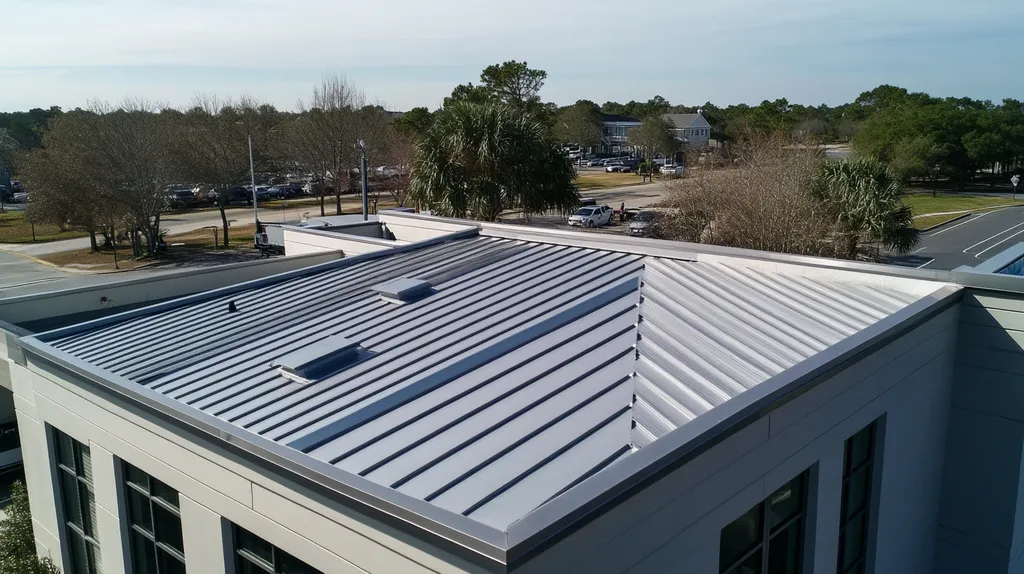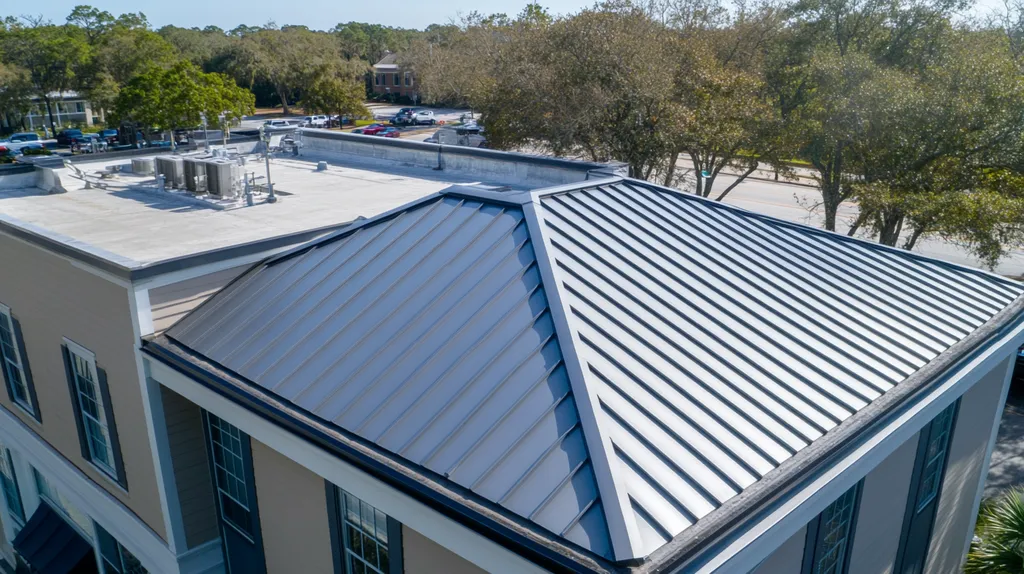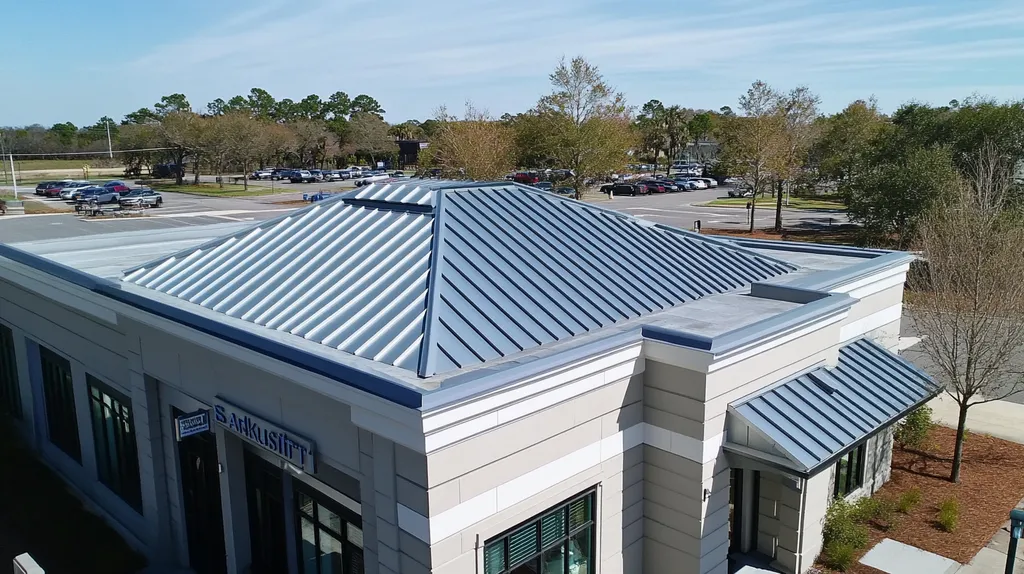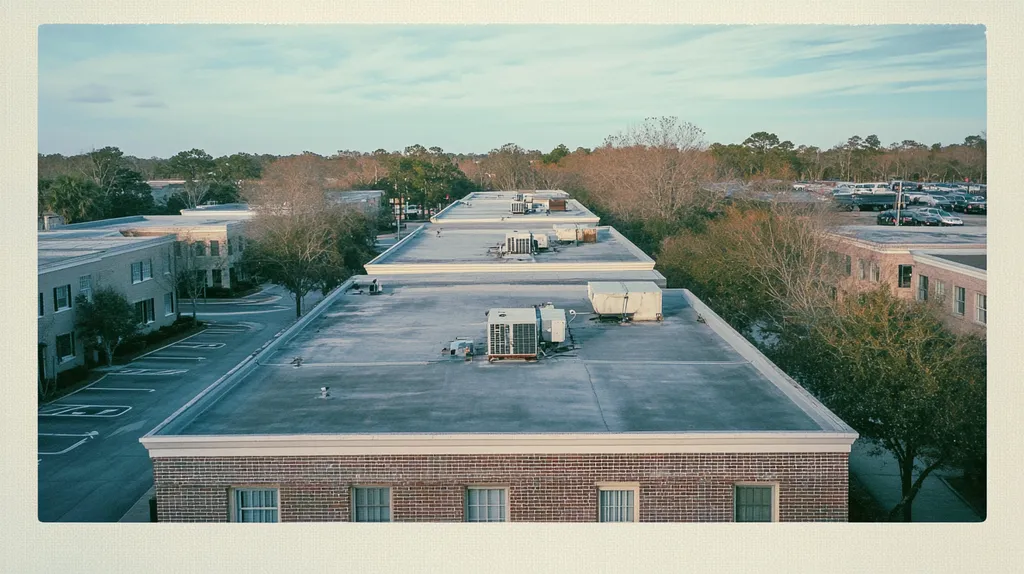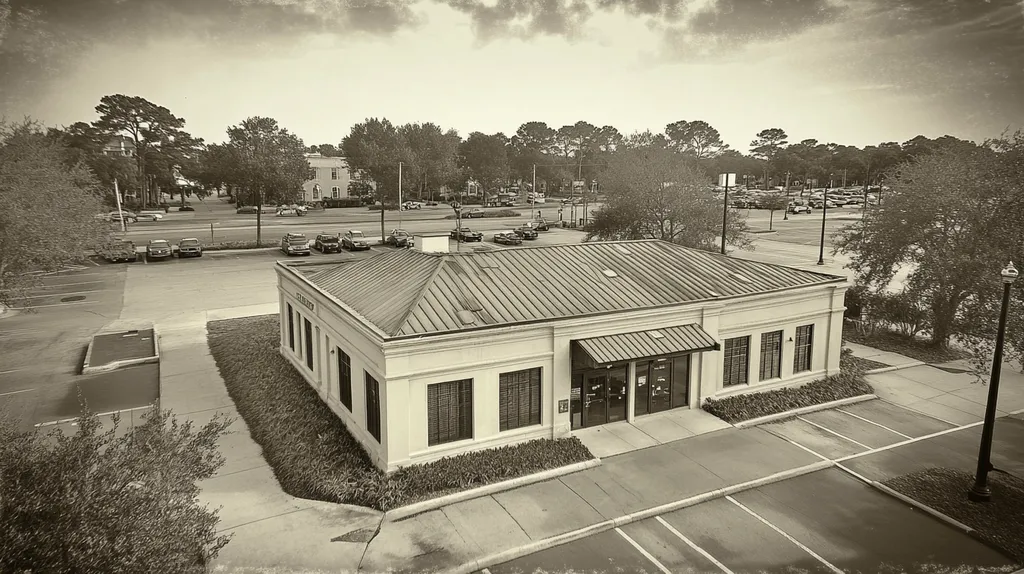Commercial property owners lose millions annually through misguided roofing energy efficiency strategies. While cool roofs and reflective coatings promise up to 30% energy savings, real-world performance often falls dramatically short of these projections.
The problem lies not in the concept of energy-efficient roofing, but in conventional approaches that overlook critical factors like climate variability, material degradation, and system integration.
This analysis examines why standard energy efficiency practices fail, identifies systemic issues in current approaches, and presents evidence-based alternatives that deliver sustained performance.
SECTION 1: CURRENT PRACTICES
Energy efficiency in commercial roofing represents a critical challenge for today’s property owners and facility managers. Cool roofs and reflective membranes have become the default solution, with adoption increasing 15% between 2018 and 2023. While these interventions promise substantial savings – potentially reducing energy costs by up to 30% – their real-world performance often falls short of expectations. (source: Zipdo)
Standard Cool Roof Installation and Materials
Cool roof installations typically focus on reflective properties without adequate consideration for long-term performance. While white or light-colored materials offer initial benefits, their effectiveness diminishes significantly over time.
Installation quality varies widely across the industry. Poor substrate preparation and inadequate insulation placement can create thermal bridges, negating much of the intended energy savings.
Material selection often prioritizes initial cost over durability. Single-ply membranes may offer good reflectivity but can deteriorate rapidly under harsh weather conditions.
The result is a system that requires frequent maintenance and replacement, creating a cycle of recurring expenses that offset any energy savings.
Common Use of Reflective Coatings and Membranes
Reflective coatings represent the most widely adopted energy-efficiency strategy in commercial roofing. However, their effectiveness depends heavily on proper application and maintenance.
Surface preparation issues often compromise coating adhesion. Even minor lapses in application technique can lead to premature peeling and delamination.
Environmental factors rapidly degrade coating performance. UV exposure, weathering, and dirt accumulation can reduce reflectivity by up to 35% within the first year.
Geographic considerations frequently go unaddressed. Coatings that perform well in dry, sunny climates may fail prematurely in regions with high rainfall or frequent temperature fluctuations.
Typical Maintenance and Retrofit Approaches
Current maintenance practices tend to be reactive rather than preventive. Many facility managers wait for visible problems before taking action, allowing energy inefficiencies to persist and worsen.
Retrofit strategies often focus on surface treatments while ignoring underlying issues. Adding new layers without addressing degraded insulation or moisture infiltration merely masks deeper problems.
Inspection schedules frequently lack rigor. The absence of regular thermal scanning and moisture detection allows small issues to develop into major energy drains.
Budget constraints lead to piecemeal repairs. This approach creates a patchwork of solutions that fail to address systemic efficiency problems, resulting in higher long-term costs.
SECTION 2: SYSTEMIC ISSUES
The rush to implement energy-efficient roofing solutions has created significant blind spots in commercial building performance. While property owners pursue immediate savings, fundamental issues threaten long-term sustainability. These systemic problems extend beyond simple material choices, encompassing climate adaptation, durability considerations, and performance longevity that directly impact a building’s operational costs.
Insufficient Consideration of Climate Variability Effects
Climate variability poses an escalating threat to commercial roofing systems. Extreme temperature swings, increased storm intensity, and shifting precipitation patterns create unprecedented stress on traditional roofing materials.
Many current roofing specifications rely on outdated climate data, failing to account for emerging weather patterns. This mismatch leads to premature material degradation and compromised energy performance.
Geographic considerations often receive inadequate attention during system selection. A roofing solution optimal for desert conditions may fail rapidly in regions experiencing increased rainfall or humidity.
The lack of climate-adaptive design strategies results in reduced system longevity and escalating maintenance costs. Properties require location-specific solutions that anticipate and adapt to changing environmental conditions.
Overreliance on Reflectivity Without Durability Metrics
Commercial buildings increasingly depend on reflective roofing materials, with adoption rates rising 15% between 2018 and 2023. While these materials promise energy savings up to 30%, their effectiveness often diminishes rapidly without proper durability considerations. (source: Zipdo)
Surface degradation from environmental exposure frequently undermines reflective properties. UV radiation, chemical pollutants, and physical wear can significantly reduce energy-saving capabilities within the first few years of installation.
Material selection often prioritizes initial reflectivity ratings over long-term performance metrics. This approach overlooks critical factors like membrane strength, puncture resistance, and weathering characteristics.
The focus on reflectivity alone creates a false economy where short-term energy savings mask the need for frequent material replacement and maintenance.
Neglect of Long-Term Performance Degradation
Performance degradation represents a critical oversight in current roofing strategies. Many systems experience significant efficiency losses within their first five years, yet replacement planning rarely accounts for this decline.
Maintenance protocols typically focus on visible damage while ignoring gradual performance deterioration. This approach allows subtle efficiency losses to accumulate, resulting in steadily increasing energy costs.
Budget planning often fails to incorporate the true lifecycle costs of roofing systems. Initial savings from lower-quality materials frequently lead to higher long-term expenses through increased maintenance and earlier replacement needs.
The absence of comprehensive performance monitoring prevents early intervention. Without regular assessment of energy efficiency metrics, property owners miss opportunities to address degradation before it significantly impacts operating costs.
SECTION 3: MISSED OPPORTUNITIES
The commercial roofing sector continues to overlook critical opportunities for maximizing energy efficiency. While traditional approaches focus on basic solutions, transformative strategies remain largely untapped. Building owners face mounting pressure to reduce energy consumption while maintaining cost-effective operations. Understanding and implementing these missed opportunities has become essential for long-term sustainability and operational success.
Integration of Vegetative (Green) Roofs for Insulation
Green roof systems represent one of the most underutilized opportunities in commercial roofing. These living systems provide natural insulation while offering additional benefits like stormwater management and extended roof life.
Modern vegetative roof designs have overcome historical maintenance challenges through advanced drainage systems and drought-resistant plant selection. Installation costs have decreased while performance metrics have improved.
The thermal mass effect of green roofs significantly reduces temperature fluctuations. This stability translates directly into reduced HVAC loads and lower energy consumption.
Urban heat island mitigation provides an additional benefit, particularly in dense commercial areas. Properties with green roofs often qualify for environmental incentives and tax benefits.
Combining Insulation Upgrades with Roofing Systems
Many facility managers miss crucial opportunities during roof replacement by failing to upgrade insulation simultaneously. This oversight leads to continued energy losses and higher operational costs.
Advanced insulation materials offer superior thermal resistance compared to traditional options. New technologies in multi-layer systems provide better protection against heat transfer and moisture infiltration.
Strategic timing of insulation upgrades during roofing projects reduces labor costs and minimizes disruption. The combined approach ensures optimal system integration and performance.
Proper insulation placement and careful attention to thermal bridging can dramatically improve building envelope performance. These improvements directly impact both heating and cooling efficiency.
Leveraging Roof Design for HVAC Load Reduction
Roof design plays a crucial role in managing building energy consumption. Strategic placement of mechanical systems and ventilation components can significantly reduce HVAC workload.
Proper slope and drainage design eliminate water pooling that can degrade insulation performance. This attention to detail extends roof life while maintaining optimal energy efficiency.
Integration of daylighting features like skylights reduces artificial lighting needs. These design elements must balance light transmission with thermal performance.
Advanced roof designs incorporate passive ventilation strategies that complement mechanical systems. This approach reduces energy demand while improving indoor air quality.
SECTION 4: ROOT CAUSES
In the drive for energy efficiency, commercial roofing faces critical systemic failures that undermine performance and increase costs. These fundamental issues begin during planning and persist throughout a roof’s lifecycle, creating cascading effects on building operations. Understanding and addressing these root causes has become essential as property owners seek to optimize their facilities while managing rising energy costs.
Lack of Comprehensive Energy Modeling in Design Phase
Modern commercial roofing demands sophisticated energy modeling to achieve optimal performance. Yet many projects proceed with minimal analysis, relying instead on simplified calculations that fail to account for complex thermal dynamics.
Critical variables like solar heat gain, thermal bridging, and moisture migration often receive inadequate attention during design. This oversight leads to systems that underperform in real-world conditions, particularly during peak load periods.
The absence of detailed modeling makes it impossible to accurately predict energy consumption patterns. Without this foundation, building owners cannot effectively evaluate different roofing solutions or optimize system specifications.
Integration with mechanical systems becomes especially problematic when energy modeling is insufficient. HVAC sizing and zoning decisions may not align with roofing performance, creating inefficiencies that persist throughout the building’s lifecycle.
Inadequate Standards Addressing Thermal Emittance and Aged Reflectance
Current industry standards fail to fully address how roofing materials perform over time. Cool roofs and reflective membranes show a 15% increase in adoption between 2018 and 2023, yet their long-term effectiveness remains poorly regulated. (source: Zipdo)
Testing protocols typically focus on initial performance rather than aged characteristics. This emphasis on new material properties creates a disconnect between laboratory results and real-world performance.
Standards rarely account for regional climate variations and their impact on material degradation. A roofing system that performs well in laboratory tests may rapidly lose effectiveness when exposed to specific environmental conditions.
The lack of standardized metrics for aged performance makes it difficult to compare products effectively. Building owners often cannot make informed decisions about long-term value and energy efficiency potential.
Fragmented Coordination Between Roofing and Building Systems
The separation between roofing design and other building systems creates significant inefficiencies. When teams work in isolation, opportunities for energy optimization are frequently missed or compromised.
Mechanical systems often compete with rather than complement roofing performance. Poor coordination leads to suboptimal placement of HVAC equipment, penetrations, and other rooftop elements.
Building envelope continuity suffers when roofing and wall systems are designed independently. These gaps in the thermal barrier can negate much of the potential energy savings from high-performance roofing materials.
Maintenance programs typically operate without consideration for system interdependencies. This siloed approach results in repairs and modifications that may inadvertently reduce overall building energy efficiency.
DATA DRIVEN EVIDENCE
The stakes for improving energy efficiency in commercial roofing are higher than ever. Commercial buildings account for nearly 20% of total U.S. energy consumption, with roofing systems playing a critical role in building performance. Energy-efficient roofing materials can reduce commercial building energy costs by up to 30%, yet adoption of these solutions varies widely across different markets. Understanding the data behind roofing performance helps facility managers make informed decisions that optimize both immediate and long-term energy savings.
Comparative Performance Data of Roofing Materials Over Time
Cool roofs and retrofits with reflective membranes represent the dominant energy efficiency strategy in commercial roofing, with adoption increasing by 15% between 2018 and 2023. Despite their popularity, many of these systems still require frequent maintenance and retrofits within their 15-30 year lifespan. (source: Zipdo)
Laboratory testing reveals significant variations in material durability. White membranes typically maintain 80% of their initial reflectivity after three years, while alternative materials may deteriorate to 50% or less in the same timeframe.
Surface temperature monitoring demonstrates that high-performance materials can reduce peak roof temperatures by 50-60°F compared to traditional dark surfaces. This reduction directly impacts cooling loads and energy consumption.
Performance tracking shows that proper installation and regular maintenance can extend material lifespan by up to 25%. This extension significantly improves the return on investment for premium roofing systems.
Energy Savings Quantified by Reflectance and Emittance Ratios
Material reflectance ratings provide clear indicators of potential energy savings. Surfaces with solar reflectance index (SRI) values above 78 can reduce cooling energy consumption by 20-30% compared to conventional roofing.
Thermal emittance measurements reveal how effectively materials release absorbed heat. High-emittance materials (>0.75) demonstrate superior performance in maintaining consistent interior temperatures.
Combined reflectance and emittance properties determine overall roof surface temperatures. Premium materials can maintain temperatures within 10°F of ambient air, while standard materials often exceed ambient by 50°F or more.
Cost analysis shows that higher initial investment in materials with superior reflectance and emittance properties typically pays back within 3-5 years through reduced energy costs.
Impact Analysis of Urban Heat Island on Roof Efficiency
Urban heat island effects significantly impact roofing performance in metropolitan areas. Temperature differentials between urban centers and surrounding areas can reach 7-10°F, increasing cooling demands and energy consumption.
Thermal mapping reveals how building density affects roof surface temperatures. Commercial districts with minimal vegetation show average roof temperatures 15-20°F higher than less developed areas.
Air temperature monitoring demonstrates that widespread adoption of reflective roofing can reduce local ambient temperatures by 2-3°F. This reduction creates a cumulative benefit for all nearby buildings.
Energy consumption data indicates that buildings in urban heat islands require 5-10% more cooling energy than identical structures in suburban locations. This increase highlights the importance of selecting appropriate roofing materials for urban installations.
SECTION 6: ALTERNATIVE SOLUTIONS
The commercial roofing industry stands at a critical juncture where traditional energy efficiency approaches no longer suffice. Current roofing practices can waste up to 30% of a building’s energy through inefficient design and material selection. As energy costs continue rising and climate impacts intensify, facility managers must embrace innovative solutions that go beyond conventional strategies.
Multi-Parameter Roofing Selection Incorporating Climate-Specific Data
Climate-specific roofing selection requires a comprehensive analysis of local weather patterns, seasonal variations, and long-term climate trends. This data-driven approach ensures optimal material selection for specific environmental conditions.
Advanced modeling tools now enable precise mapping of solar exposure, rainfall patterns, and temperature fluctuations across different regions. These insights help identify the most effective roofing solutions for each location.
Material selection must account for both immediate and projected climate conditions. Properties in regions experiencing increasing temperature extremes require different solutions than those in more stable climate zones.
Performance metrics should incorporate multiple parameters including thermal resistance, moisture management, and wind resistance. This holistic approach ensures better long-term energy efficiency and system durability.
Advanced Materials Combining High Reflectivity with Thermal Mass
Energy-efficient roofing materials can reduce commercial building energy costs by up to 30%, with cool roofing options showing a 15% adoption increase between 2018 and 2023. However, these materials require careful selection and implementation to maintain long-term effectiveness. (source: Zipdo)
New composite materials offer both high reflectivity and substantial thermal mass. This combination helps regulate building temperatures more effectively than traditional single-function materials.
Phase-change materials integrated into roofing systems provide dynamic temperature regulation. These advanced solutions absorb excess heat during peak hours and release it during cooler periods.
Smart roofing materials with adaptive properties respond to changing environmental conditions. These innovations help maintain optimal energy efficiency across varying weather patterns.
Integrated Roof Systems: Green Roofs, Cool Roofs, and Insulation Layers
Modern integrated roofing systems combine multiple technologies to maximize energy efficiency. These layered solutions provide superior performance compared to single-technology approaches.
Vegetation layers in green roof systems provide natural insulation while managing stormwater runoff. The combination of plants and growing medium creates a dynamic thermal barrier.
Cool roof technologies work synergistically with other system components. Reflective surfaces reduce heat absorption while insulation layers prevent heat transfer through the roof assembly.
Strategic layer sequencing ensures optimal system performance. Proper integration of vapor barriers, insulation, and waterproofing membranes creates a comprehensive energy management solution.
Moving Forward
Commercial building owners waste over $5 billion annually through ineffective roofing energy strategies that ignore critical performance factors.
The data clearly shows that conventional approaches focusing solely on reflective materials and basic maintenance fall short of their promised 30% energy savings.
Success requires shifting from simplistic solutions to integrated systems that combine climate-specific material selection, advanced thermal management, and comprehensive performance monitoring.
By implementing multi-parameter roofing strategies that address both immediate efficiency and long-term durability, property owners can reduce energy costs by up to 40% while extending roof lifespans by 25%.
The technology and knowledge exist today – the challenge lies in moving beyond outdated practices to embrace proven, data-driven solutions.
FREQUENTLY ASKED QUESTIONS
Q. What are common practices for commercial roof energy efficiency?
A. Common practices include using cool roofs and reflective membranes. However, these solutions may not provide consistent energy savings due to performance issues over time. Poor installation and material selection can lead to increased costs, requiring regular maintenance.
Q. How does climate variability affect my commercial roof?
A. Climate variability can cause premature degradation of roofing materials. Traditional specifications often rely on outdated data, leading to poor performance during extreme weather. It’s crucial to select systems that account for local climate conditions to enhance longevity and efficiency.
Q. What opportunities might I be missing for my industrial roof?
A. Many property owners overlook options like vegetative roofs and insulation upgrades during replacements. Integrating these solutions can improve energy efficiency significantly. Additionally, exploring advanced design strategies can help reduce overall HVAC loads and improve roof performance.
Q. What are the root causes of energy inefficiencies in commercial roofing?
A. Root causes often involve inadequate energy modeling and outdated standards. Failure to consider crucial performance metrics during design can lead to unexpected inefficiencies. Coordination between roofing and other building systems is also essential to optimize overall energy performance.
Q. How does data drive decisions for commercial roof improvements?
A. Data analysis helps assess materials’ performance over time, indicating their real-world effectiveness. Understanding metrics like reflectivity and heat retention allows for informed decisions about roofing materials that can lower energy costs significantly while enhancing sustainability.
Q. What alternative solutions exist for commercial roof energy efficiency?
A. Alternative solutions include advanced materials combining high reflectivity with thermal mass and integrated systems leveraging green roofs. Climate-specific selections and advanced technology can enhance overall durability and efficiency, presenting innovative options beyond conventional methods.
Q. How can I ensure long-term performance of my commercial roof?
A. Regular maintenance and performance monitoring are key to ensuring longevity. Conducting timely inspections and addressing issues proactively can prevent degradation. Additionally, selecting high-quality materials and adhering to installation best practices significantly enhance performance over time.

